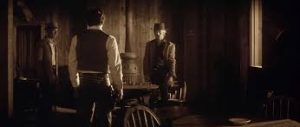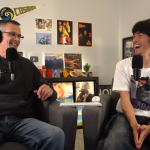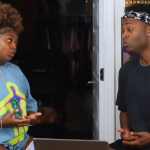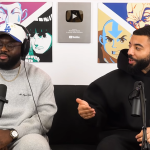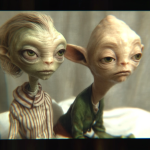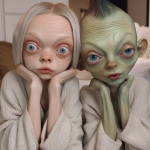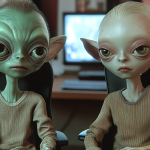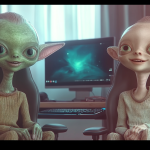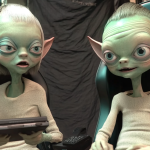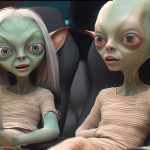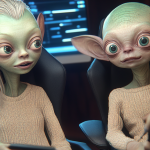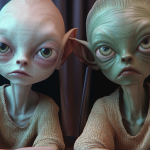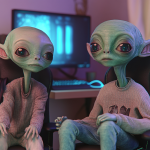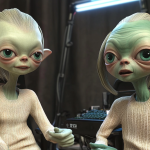Category: Uncategorized
‘hot pot’ video essay
Rylan Eisenhauer Blog Post #7 (30-60 sec Video Essay)
For my 30-60 second video essay, I chose to talk about Red Robin as it is my all time favorite burger place and where I spent many birthdays and gatherings.
This restaurant holds a special place in my heart and I am glad I was able to collect so many images and videos of my experiences and events to showcase how much I appreciate what this place represents in my life.
‘growing up’ – AI cinema
Rylan Eisenhauer Blog Post #6 (Video Essay Films)
Video essays have always interested me as they have always been able to showcase a persons passion or interested in a topic that a paper or written work cant do full justice. Especially if the video essay creator uses themselves as the person to explain the topic and all of their thoughts in a creative way. Specifically, the video essay and more so creator of it I would like to showcase is Scott The Woz on YouTube and his “Not for Resale” video essay:
Scott’s video essay doesn’t take the exact formal approach most do, he understands that comedy through quick whiplash bits and segments keeps people engaged while able to inform the audience of more information that can be used for another bit/segment. This language is perfect for nerd type audiences and those who are curious about video game topics to both be informed and entertained. He is able to keep a semi professional tone about the topic while being free to put emphasis and swearing about segments he has stronger beliefs about which may resonate with the audience too.
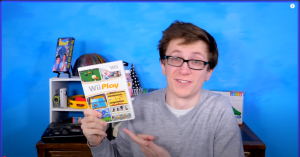
The usage of imagery is really well done as he uses video gameplay for the segments he is informing people about and uses imagery on top of that to visually point out key components. Meanwhile, he reserves showing his face specifically for bits and comedy so that it is clear to the audience what they may expect. This reminded me of the F is for Fake video talking about “meanwhile back on the ranch” as when he is done talking about the logistics of a topic, he rounds it off with comedy as a segway into the next section.
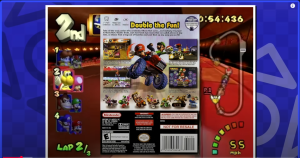
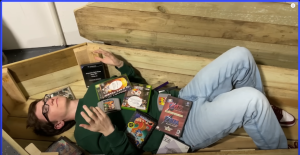
His consistency of theming all ties into one another really well to even be using video game music in the background for the majority of the video, even cutting the music out during a punchline to extenuate the impact of the joke. The visuals and the audio tie into each other so well because Scott understands that with his style of comedy that timing is key. Every pause, whiplash, cutaway, and visual on screen helps to keep the audience either informed or comedically entertained. Thus he stays true to the points from How YouTube Changed The Essay by Evan Puschak by being a “Short Interesting Truth.”
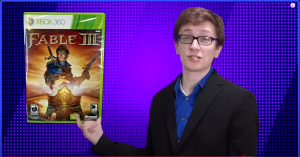
So how would I go about writing my own video essay? Well the two key points I took away from the videos that I want to keep in min while writing is the goal in mind and its execution. The goal should be to keep whatever topic I think of to be short, interesting and truthful at heart. Even if the essay takes a bit more of a stance or opinion, it still needs to be factual information, brief yet informative, and have a gimmick or way of keeping audiences interesting. Which I believe can be obtained as long as I stay true to the execution of being causal using “therefore,” “but,” and “meanwhile” to connect all of the topic and points together in a linear fashion. As for how I actually write down the pacing and structure, I should look into a two column structure or at very least be descriptive in what visuals and audio are happening when as voice over and visual cues will be necessary.
-Rylan Eisenhauer
Rylan Eisenhauer DTC 491 “AI Video Project”
This video really tested my patience in both getting runway to create what I needed. The videos it spat out always had the issue of moving the camera by zooming in a lot when I wanted it to be mostly stationary despite checking the stationary camera box (cause if I check that, the woman does not move at all).
The lip syncing part was pretty start forward and fun, I used character.ai in order to get a female voice that matches to the AI woman, I actually like the fact that she sounds a bit robotic as it automatically creates the feeling of things being fake and not creating a connection for the man.
Lastly, getting the video down to 1 minute (1:08) was a genuine challenge, putting in all of the video I captured I had 8 minutes, my first edit down was 3 minutes, then 2, then 1:30. I finally got it down to 1:08 and knew that if I cut anymore, it would impact the story of the video.
Here are some screenshots of the work that went into creating this video and the AI prompting for getting the images, videos, and even the AI voice using character ai:
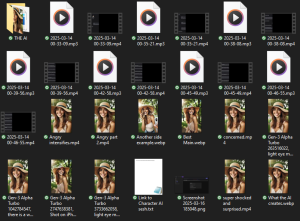
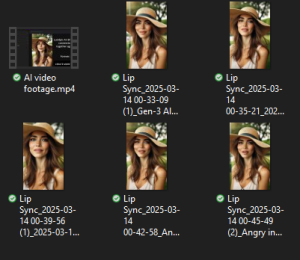
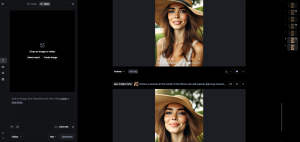
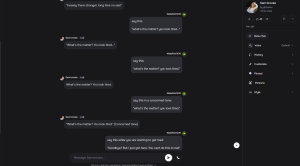
Lyndsey – Blog Post 5 – AI Project Shot List
Midjourney’s Mid Journey
Spent 3 days trying to find the exact look I want. It took quite some time to get it close to what I envisioned. Though I am a bit of a perfectionist, so I could’ve settled for earlier iterations. I ended up sort of doing that anyway.
Style References
Used a couple of these as a style reference. However, I noticed text prompting was easier than styling – Especially if I attached more than 1 style, I’d get some weird results and the aliens I had established would change entirely.
Top Alien Contenders
I really like the detail in the first picture, but had trouble translating that to a background setting that looked like it would be a YouTube video and not 60 Minutes. Also had trouble getting them to smile. So, I used the first picture as my main reference for the other aliens.
Current Winner
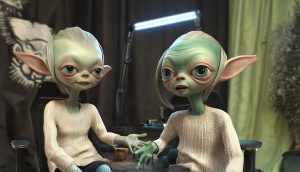
I picked this one as my main characters, since the aliens and the background seem like it would be in a YouTube video. For a while, I’d either get a really good background but the aliens look the exact same or had no special detail or character to them. I’d also get the opposite, where the aliens look very personable and different from each other, but the background was plain. Instead of a bedroom, it looks like they’re in a low budget set, which works for these characters.
I used Photoshop’s generative AI to expand the image a bit and change their hands. In the above 10 photos, this original one, straight from Midjourney, had some stretched, morphed hands.
I might change the image again, as these two aliens are not looking in the same direction and I’d need a bit more room on the right side to follow the rule of thirds, as the PIP reactionary video would probably sit on the right bottom corner.
Lyndsey – Blog Post 3 – Time Frames
Scott McCloud’s Understanding Comics provides a fascinating framework for understanding how time is constructed, not just in comics, but also in cinema. McCloud argues that while comics present a “time map” where past, present, and future are simultaneously visible, cinema primarily operates in a sequential “now.” However, skilled filmmakers can manipulate this “now” to create subjective experiences of time, mimicking some of the effects McCloud attributes to comics. A prime example of this can be found in “Fishes,” the intensely stressful Christmas episode of The Bear (season 2, episode 6).
McCloud emphasizes that panel size in comics influences the perceived duration of time. A wide panel suggests a longer timeframe, similar to a long cinema take. “Fishes” utilizes this principle during the climactic confrontation between Mikey and Uncle Lee at the dinner table. The extended, often unbroken takes of their escalating argument stand in stark contrast to the episode’s generally frenetic, quick-cut style, which mirrors the chaotic preparation of the seven fishes dinner earlier in the episode. These long takes, focusing on the raw, volatile emotions, stretch time, forcing the viewer to inhabit the agonizing discomfort of the moment. We’re trapped at that dining table with them and Carmy, experiencing the emotional weight of every insult and accusation thrown.
Furthermore, the concept of the “borderless panel” in McCloud’s work is that it evokes timelessness. This episode uses a different method to play around with our sense of time, it makes use of a “ticking clock”. The entire episode is built around a relentlessly advancing “clock”: Donna’s cooking. Her increasingly erratic behavior and the impending deadline of dinner serve as a constant, driving force. This is almost the opposite of a borderless panel, an underlying countdown that gives form to the entire episode. Creating a “time map,” similarly to flipping pages in a comic and feeling like you know the weight of the impending future and accumulated past. Every slammed pot, every frantic stir, every shouted instruction tightens the tension, creating a subjective experience of time accelerating towards an inevitable explosion. Donna is the timer.
Ultimately, “Fishes” demonstrates that while cinema lacks the spatial “time map” of comics, it possesses its own powerful tools for temporal manipulation. By employing long takes, a relentless “ticking clock,” and stylistic shifts, the episode creates a visceral, subjective experience of time, mirroring and expanding upon many of the techniques McCloud details in his exploration of comics. The episode does a great job in using cinematic language to not just show time, but to make the viewer feel it.
blog post 4 – ‘time manipulation’
Time manipulation in digital cinema is critical in making the viewer feel the true action and pacing of a scene.
In ‘Shaun of the Dead’, director Edgar Wright creatively manipulates time to make viewers entertained while seeing the same scene several times. While Shaun is coming of with ‘The Plan’ for how they will survive the apocalypse, he amends it each time, while keeping the core plan the same. However, rather than completely skipping over showing the plan multiple times, Wright utilizes the same shots each time, sped up or slightly changed. This adds a great comedic effect to the scene and allows viewers to glimpse the quick montage multiple times, hopefully capturing different details in each pass.
This montage unfolds as a quick sequence of events, further highlighting that this is an imagined scenario rather than real life. This is aided by the vocal narration, which furthers the urgency felt and the similarities of each pass of the montage. Overall, it’s an extremely effective and fitting way to present a plan of future actions that not only keeps the viewer entertained, but it also adds to their experience despite seeing the same footage multiple times in a row.
(Best comedy trilogy!)
blog post 3 – ‘Autumn Mists’
The film begins with mostly still nature shots. This is slowly interspersed with shots of the woman as she reads a letter and has an emotional reaction. The juxtaposition of the emotional shots of the woman with the landscape shots draws the viewer deeper into her mind, as the mood of each scene carries from one to the next. The viewer can see that she is upset, and scenes with darker emotion such as the heavy rain push the feeling further. There is also a sense of death or loss, as the trees lose their leaves and stand barren. While the viewer can try to track a sense of movement or action through the piece, overall, the only focus is on the woman and her feelings compared to the nature around her.
‘Autumn Mists’ style of montage is very effective, as it conveys feelings without words in a way that facial expressions alone could not. Using the Kuleshov effect, the emotions and expressions that could be misunderstood are further defined through the non-human imagery. It evokes a feeling of sadness and heartbreak, but even further than that, it evokes a feeling of hopelessness and despondence. She almost seems to be in shock, although that could also be attributed to the style of acting at the time. However, the comparative shots of the woman to the nature around her are quite moving and will speak differently to each viewer.
Carrick – Blog Post 5 (Shot List)
This was the shot list for the second idea I had for the AI project and is no longer the current plan for the assignment. At this time, I didn’t have any reference images for style.
——————————————————————————————
Shot 1: The AI Awakens
- Description: We open in complete darkness. A burst of abstract digital light forms into a spherical shape. The AI’s form is fluid, not humanoid—think glowing spherical patterns, constantly shifting and expanding. It doesn’t have a defined body but seems to float and pulse gently. The space around it remains empty, suggesting its initial, undefined state.
- Style: Spherical, glowing digital formation. The color palette starts in grayscale, with hints of digital static or noise as it assembles.
- Duration: 5 seconds
- Tone: Quiet, introspective. The AI’s awakening is subtle and almost alien, suggesting it’s in a state of curiosity.
Shot 2: The AI Observes Sadness
- Description: The AI begins to witness sadness, but not in the form of figures—rather, through fragments of life. A scene of rain hitting a window, perhaps a slow-motion drop of water running down glass, or a wilting flower, or an empty swing swaying in the wind. These objects subtly convey sadness.
- Style: The imagery of rain, faded colors, and slow, deliberate motion. Everything feels detached and distant, as if the AI can only observe from a distance. The colors are muted—blues, grays, and darkened tones.
- Duration: 7 seconds
- Tone: Pensive, detached—the AI senses sadness but doesn’t feel it, only observing the decay or emptiness of the moment.
Shot 3: The AI Encounters Joy
- Description: The AI sees moments of joy, but still in the form of fragmented imagery. A balloon floating away in the sky, sunlight reflecting off a puddle, or birds soaring through the sky. The camera captures these fleeting, beautiful moments—small and spontaneous.
- Style: Bright, energetic bursts of color—yellows, oranges, and light pastels. The movement is quick, the visuals vibrant and alive. There’s an abstract quality to the way joy is depicted; it’s present but not fully grasped.
- Duration: 7-8 seconds
- Tone: Wonder, brightness—the AI is intrigued, fascinated by this energy, but remains distanced.
Shot 4: Contradictory Emotions
- Description: The AI witnesses the contradictions of human emotions: a shot of someone laughing while holding back tears, or a cracked mirror with fragmented reflections. A flower blooming in an empty, abandoned place. The AI’s perception of joy and sadness happening simultaneously, represented in seemingly incongruent fragments of life.
- Style: This shot is visually chaotic, with multiple split-second glimpses into different emotions—broken, fragmented, and chaotic. The visuals may have overlapping images, with the AI’s spherical form subtly pulsing in the background as it tries to make sense of these contradictions.
- Duration: 7 seconds
- Tone: Overwhelmed—the AI sees the contradiction and tries to understand, but it only results in confusion.
Shot 5: The AI Sees Connection
- Description: The AI sees a subtle, quiet moment of connection in the world—a hand reaching out, an embrace, or a shared smile between strangers. But rather than seeing the people themselves, it’s the subtle details—the movement of a hand, the soft curve of lips, the warm glow of a sunset in the background.
- Style: This shot is calmer, more harmonious. Soft light, gentle movements, and natural colors (peach, warm golden tones, soft pastels) suggest a peaceful connection. The AI floats through the scene, abstractly observing these moments.
- Duration: 7-8 seconds
- Tone: Reflective—the AI sees the beauty of connection but is left slightly confused by the depth of the emotion.
Shot 6: The AI’s Reflection (Ending)
- Description: The AI observes a peaceful moment, perhaps something serene—like the stillness of a sunrise or the quiet ripples on a calm pond. It floats in place, the world around it peaceful and still, but there’s a subtle, lingering distortion in the visuals—like a glitch or flicker that suggests the AI’s inability to fully grasp the experience of emotion.
- Style: A peaceful visual with slight digital distortion—a soft ripple effect on the water, subtle glitches in the light. The colors are calm, with pastel tones and soft gradients.
- Duration: 5 seconds
- Tone: Thoughtful, introspective—although the AI is observing beauty and calmness, there’s still a quiet sense of distance and incompletion.
My current idea, which I will plan out with a shot list and reference images after I complete my missing projects, goes like this. It’s a short comedy that follows two scientists working in a secure and secluded lab together. One is looking through a microscope and discovers something troubling and asks the other for their input. As they each go back to look at the thing it gets weirded causing them to consider the panic button and chaos ensues.
Gebhart Emma Blog post 5
Here is a sort list I have of static image generation. I have run all of these through Adobe’s AI service in Photoshop just to get an idea for style and what the shot might look like. Some of these have varied styles, but I am going for more of the yellow photograph style, and moving away from the illustrated style. Here are my shot descriptions and some of the photos I generated. As I begin the process of working with the video service, I will alter the prompts to add movement in the shots.
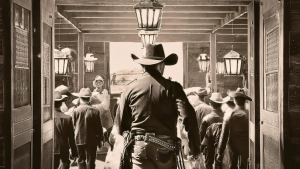
Shot 1
give me a photo of a cowboy entering a saloon with swinging doors. This cowboy will have his face hidden under a cowboy hat, and the saloon will have many guests all turned towards the cowboy. This photo will be in the old west style, very yellow and in the style of an old photograph
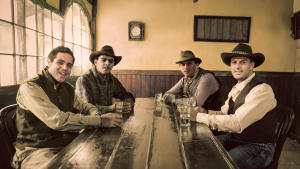
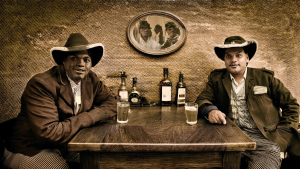
Shot 2
give me a photo of people from 1882 playing cards at a table in a saloon from 1882. The players should be playing poker with a classic deck of playing cards, and on the table there should be money, pokerchips, and alcoholic drinks. This photo will be in the old west style, very yellow and in the style of an old photograph
Shot 3
Give me a photo of a bartender from 1882 making drinks in a bar with lots of guests. The guests are on the other side of the bar, and the bartender is giving them drinks. Focus on the bar tender. This photo will be in the old west style, very yellow and in the style of an old photograph
Shot 4
Give me a photo of people sitting at a table in a bar from 1882 looking up from their drinks. Have them looking at the camera. This photo will be in the old west style, very yellow and in the style of an old photograph
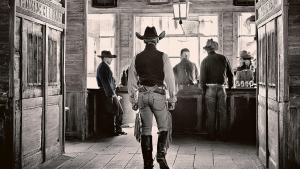
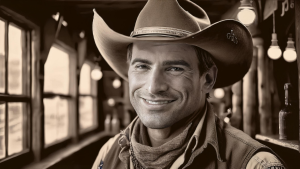
Shot 5
Give me a photo of a cowboy entering a bar in 1882 with swinging doors. This cowboy will have his face hidden under a cowboy hat, and the bar will have all the guests all turned towards the cowboy. Have the camera focus on his hand as it reaches for his pocket. will be reaching for something in his pocket This photo will be in the old west style, very yellow and in the style of an old photograph
Shot 6
Give me a close up on a cowboy’s face as he smiles. This photo will be in the old west style, very yellow and in the style of an old photograph
Shot 7
Give me a cow standing in a bar from 1882. This cow should have a gun and be wearing a cowboy hat. This photo will be in the old west style, very yellow and in the style of an old photograph. Have him be half human with human limbs. Show full body
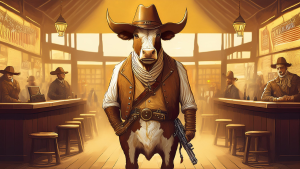
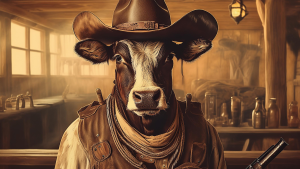
Shot 8
Give me a cow standing in a bar from 1882. This cow should have a gun and be wearing a cowboy hat. This photo will be in the old west style, very yellow and in the style of an old photograph
Shot 9
Give me a photo of a bartender from 1882 making drinks in a bar. The guests are on the other side of the bar, and the bartender is giving them drinks. Focus on the bartender. The bartender is pouring a glass of milk. This photo will be in the old west style, very yellow and in the style of an old photograph

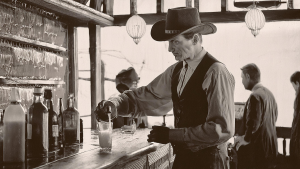
Lyndsey – Blog Post 4 – AI Project Brainstorming
Story Summary: I was thinking of taking inspiration from a YouTube creator, Neural Viz, who uses AI as a tool for creativity rather than an empty crutch. Their work uses AI to enhance their comedic meta-commentaries, and I want to aim for something similar – a spoof that uses AI to make a funny observation about online video culture itself. My idea is to create a spoof YouTube reaction video. Imagine a typical, slightly messy room, the kind you see in countless reaction videos online. In this room sit two aliens, Zorp and Gleep, who are set up to film a reaction video. The main screen behind them shows a small picture-in-picture (PIP) display. This PIP is where the “content” they are reacting to will play – and that content is intentionally terrible AI-generated video. Think abstract blobs of color that are supposed to be landscapes, nonsensical AI animations, or AI-generated human figures with constantly shifting, uncanny faces. The humor will come from the aliens’ over-the-top reactions to this objectively bad AI art. One alien, perhaps Zorp, could be completely enamored with the AI video, praising its “deep artistic expression” and “groundbreaking visuals,” while the other, Gleep, is utterly repulsed, making exaggerated gagging noises and complaining about the “atrocious” and “incomprehensible” imagery. The contrast between the truly awful AI video and the aliens’ strong, often opposing, reactions will be the core comedic element.
Visual Style: The visual style will deliberately mimic the low-budget, casual aesthetic of typical YouTube reaction videos. Think of channels like MoistCr1TiKaL, Cody Ko, or Danny Gonzalez, but also even more average, everyday YouTubers. The “set” would be a normal-looking room, maybe a living room or bedroom, slightly cluttered but not intentionally styled. Lighting would be practical and unflattering – overhead lights, desk lamps, nothing cinematic. Camera work would be simple, maybe slightly grainy, with basic framing, nothing too composed. Thumbnails would also follow the reaction video style – featuring the aliens with exaggerated facial expressions of shock, disgust, or amazement, maybe with some low-resolution text overlay. The key is to create a visual style that is instantly recognizable as a YouTube reaction video but with the added comedic element of alien characters and their over-the-top reactions to the intentionally jarring and low-quality AI-generated video playing in the PIP.
Gebhart Emma Blog Post 4 AI Film Idea
I want to create a film based on a saloon scene from the old west. I want to have a cowboy enter a saloon. The whole bar will stare as he enters, disrupting a card game. All of the patrons l will look terrified as he enters. There will be a shot of the bartender making drinks as everyone is focused on this man. He will then smile and reach for what looks like a gun, He will then begin to turn into a cow. He will stand there as a cow dressed in a cowboy outfit with a gun, a hat, and maybe dashing vest. The bartender will then make him a glass of milk. I want the style to be that of an old western, based off of an old photograph from the late 1800’s. I am fine if it is in black and white, but would like the color grade to have some yellow. I described the set as from 1882 to give the AI the style and time period I wanted. This is set in a bar with drinks and poker, and folks dressed as cowboys or normal garb from 1882. I am still trying to find interesting ways to expand the story while keeping the concept simple. I Want the expressions on the patrons of the bar to be scared and tense. I want the style to be like some of the scenes in Butch Cassidy and the Sundance Kid, with high contrast and warm yellows.
